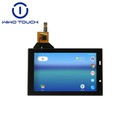What is Projected Capacitive Touch?
Projected capacitive (PCAP) touchscreens are the latest iteration of the decades-long history of touch sensor technology. The use of PCAP touchscreens has increased with the proliferation of consumer electronics, advancements in medical devices, and more complex automotive applications, creating breakthrough specializations and use cases.

The conductive mesh of the PCAP screen detects changes in capacitance, which is the mechanism behind recording touches. Combining different bonding techniques, finishes and touch controller adjustments, the ability to customize PCAP touchscreens has resulted in an endless array of highly successful touch display products.
What is the difference between PCAP and resistive touch?
PCAP technology is different from resistive touch screens.


Resistive touch sensors register a touch when force is applied to the screen. When pressed against the screen, the finger creates an indent in the top membrane, which connects to the electrodes at the bottom of the stack. This change in resistance is how touches are recognized.
PCAP screens use two layers of electrodes (X and Y) around which a capacitive electromagnetic field is created. When a finger, stylus, or other conductive object hovers or touches the screen, an electrical charge is created that enables the processing system to recognize, record and respond to the signal. For example, a finger penetrates an electromagnetic field, causing a change in capacitance.
Over the years, PCAP sensors have almost completely replaced resistive touch sensors because of their numerous advantages. They can support multi-touch, gestures, and 3D proximity sensing, and offer superior reliability and durability. This makes them ideal for automotive, consumer, medical and industrial applications that require more functionality than buttons and a single point of contact can provide.
PCAP customization
PCAP technology is highly customizable and can be designed according to the individual needs of customers. Engineers can use custom touch controller algorithms to tune PCAP touch sensors for application-specific sensitivity and accuracy. These features make PCAP touch sensors an ideal solution for demanding applications.
Chip mount
The final point of difference in PCAP touch panel design is how and where the chip is mounted. Two methods can be used:


COF (Chip-on-flex:) The controller and supporting electronics are located on a flexible substrate. This is the primary chip integration method used for touch sensors because it is thin and flexible, but may not be suitable for sensors larger than 15 inches.
COB (Chip on Board): The controller and supporting electronics are integrated on a printed circuit board (PCB). On-board chips are typically used in sizes above 15 inches, or if the customer wishes to host the touch electronics on their own board.
Bonding method
The touch, display, and cover assemblies can be bonded together in a number of ways:

Bonding of touch sensor and display:
Optical Bonding: The use of optically clear adhesives (OCA) or liquid glues to bond touch and display components together, known as optical bonding, is the best solution for many applications. In the optical bond stack, air gaps are eliminated, creating a barrier against moisture and dust, and near-perfect optical transmission with low reflectivity. This process also provides greater impact resistance, which means greater overall durability.
Air Gap Bonding: Another option for touch and display bonding is to use double-sided tape around the perimeter of the display. Although less expensive than optical bonding methods, this solution offers lower optical performance, higher chance of dust and moisture penetration, and reduced shock and vibration resistance. There are ways to reduce system reflectivity within air-bonded modules by using anti-reflection (AR) films or coatings on the air-gap surface and/or applying display polarizers.
Optical Bonding of Touch Sensor and Cover:
Optical Bonding: The touch sensor and cover assembly are always bonded together using OCA film or liquid glue. Currently, air gaps are not used to bond the two layers together, as air gaps can cause uneven touch sensitivity across the surface. Optical bonding also provides near perfect optical transmission and reduced reflections.
Contact us
Name:Yeeanl Zhang
Tel:0086-596-2607595
Email:sales09@wiwotouch.com




